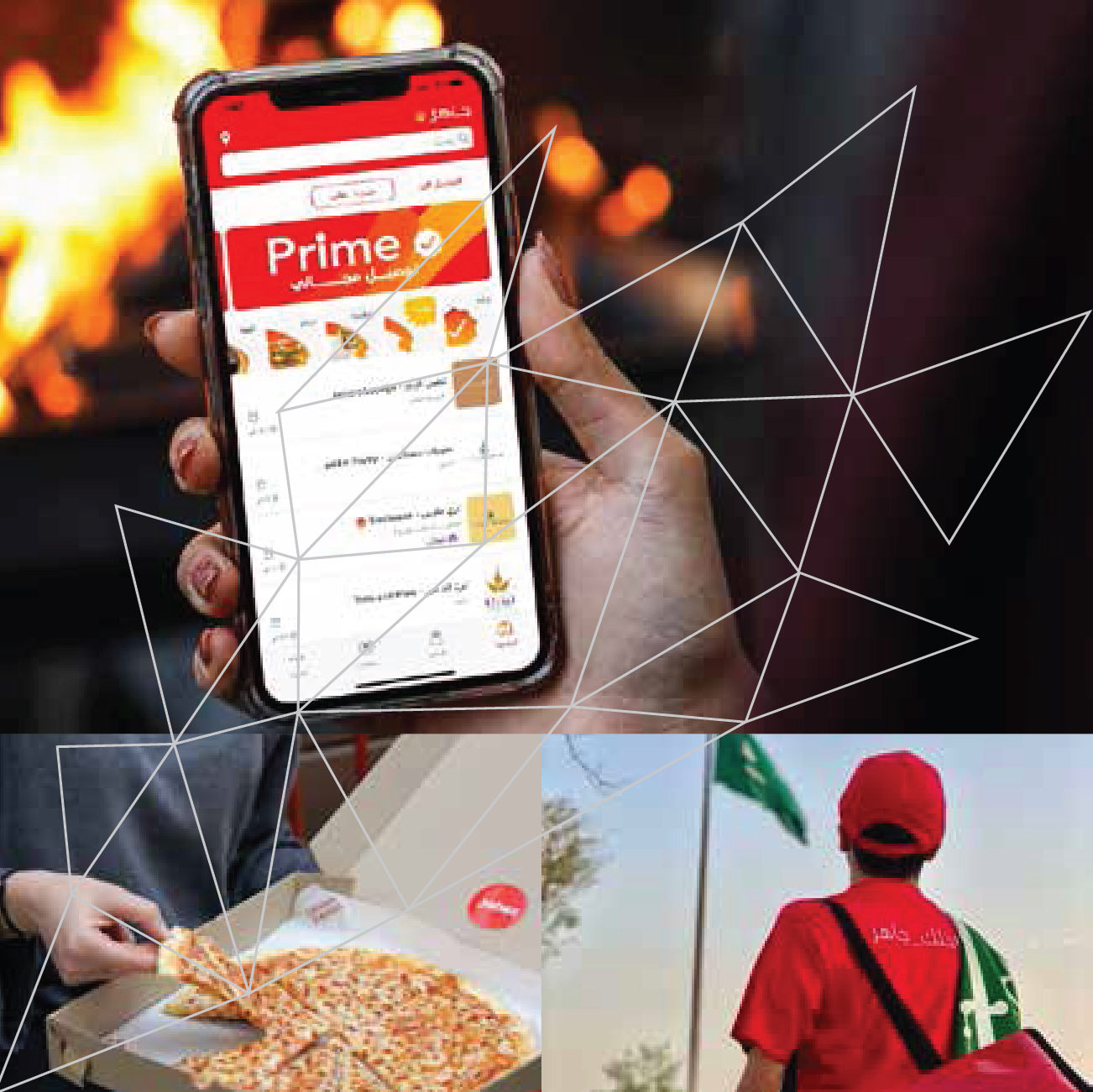
This pillar focuses on enhancing satisfaction through service excellence, productivity and technological integration.
This pillar focuses on enhancing satisfaction through service excellence, productivity and technological integration. The stakeholder groups include merchants, customers, and delivery partners. The objective of this pillar is to make sure that, even as the Group expands quickly, customer experience, which is crucial to the success of the company, will also simultaneously evolve.
The Group updated its digital solutions for Jahez, PIK and BLU Store platforms to further improve customer experience and engagement. Jahez in particular, has unveiled a new application interface that is more user-friendly and appears more contemporary. The new interface has a fresh design that will make customer experience more appealing and enjoyable.
In Q2 2022, to increase user convenience, the platform also introduced “Prime”, a monthly subscription model. Prime offers a free delivery service and exclusive meal options for a wide range of merchants.
This pillar also strengthens the Group’s commitment to enhance service excellence. Key among the initiatives would be: scheduled deliveries, boosting the customer relationship management system to streamline complaint management, and guaranteeing a swift resolution of complaints. As a result of these initiatives, the Group is effectively streamlining its operations, providing quicker delivery and complaint resolution times, as well as enabling greater engagement.
Customers - the cornerstone of our business
The Group places a high priority on acquiring new customers while retaining its current ones in order to grow its clientele and increase profitability. In its early stages, the Group relied on customer referrals to attract customers; however, as the Company grew and expanded, a varied mix of marketing and promotional strategies were employed, thereby growing its active customer base from about 473,000 in 2019 to about 2.8 million active users presently. To further expand its clientele and carry out its ambitious development plan, the Group intends to use a variety of marketing and advertising techniques, which will ultimately have an impact on the cost of luring new customers.
Data intelligence for product and service specialization
The Group strives to use the enormous amounts of data it generates and gathers in the course of its daily operations to improve both its own services and its partners’ processes. The Group regularly uses artificial intelligence (AI) and machine learning to analyze its data through its data-driven teams in order to improve its algorithms and discover fresh approaches to growing its business.
For example, forecasting high demand on Jahez, PIK and BLU Store platforms enhances recommendations for delivery partners. This enhances productivity as well as improves cost management techniques and, most importantly, customer satisfaction, as now, services can be specialized based on information received from data.
The data benefits the Company in numerous ways. Today, the Group uses the data to enhance customer recommendations, streamline business processes and marketing initiatives, and assist merchants in better understanding the needs and preferences of their customers. The Group also employs AI and machine learning to produce insight reports for internal use as well as to offer such reports and insights to merchants, helping them facilitate their operations.
A Data & AI Department was established during the year to provide data-driven solutions that are useful in a range of contexts.
As a result of data and analytics use, the Group is able to make conscious decisions that are best for the organization. The Group Data Hub, for instance, consolidates and democratizes data into a single hub in order to be used by stakeholders for monitoring and data-driven decision-making. This process benefits the Group’s operations immensely. For example, restaurants are able to expand their customer base and enhance operations based on insights received through research and market analytics.
Shared responsibility and technological integration
Mitigating cyber risks
The Group’s data and information technology systems are its most important assets for ensuring that business operations run without a hitch. As a result, the Group gives its top priority to keeping data privacy and systems security at high standards in order to maintain reliability.
Hence, one of the foundational components of the Group’s technology is cybersecurity. This demonstrates the Group’s dedication to preserving the confidentiality, robustness, and security of corporate and personal data. The Communications, Space & Technology Commission (CST) and ISO 27001 regulations are being gradually implemented by using a gap analysis process to identify the areas that need to be developed. The Group is also adapting a risk assessment process based on C.I.A. (Confidentiality, Integrity, Availability) to build a cybersecurity strategy with a road map for three years.
Important security measures are put in place by the Group to authenticate Jahez, PIK and BLU Store users, including clients, merchants, delivery partners, and administrative users, on its systems.
Encryption and masking are also used to further protect all data sent over a secure network. By using security-managed services, the Group is also protected from cyber attacks and the risks associated with lowered security. The Group ensures that all of its Departments, from the point of development to the point of delivery, adhere to cybersecurity policies.
The goal of the Group is to protect all customer data from the risks of piracy in a sufficient manner. As a result, the Company consistently makes investments in the growth of its systems, infrastructure, and workforce. The Group’s process for cybersecurity management is to first run the codes through Development, Security, and Operations (DEV, SEC & OPS) to ensure their accuracy. Strict vulnerability management is carried out on a daily basis, and stringent monitoring of traffic on all servers and employee devices happens through the Security Operation Centre (SOC).
Enhancing service propositions
The Group’s technological platforms enable stakeholders to work more effectively while also giving them access to crucial data that will help them increase the productivity of their service offerings.
For instance, insights are offered to restaurants based on their performance and relationships with customers to improve the quality of service. A heat map was also created so that drivers could monitor demand and fill as many orders as they could. Additionally, a subscription model has been added to the BLU Store platform. As for PIK, we have created a user-friendly portal for store management so that retailers can quickly add offers and discounts for particular products for customers.
A straightforward and efficient mobile application makes it easy to onboard delivery partners into the Group and efficiently pay them. These important differentiators are only possible with an obvious commitment to offer a user-centric experience.
R&D for knowledge creation and service improvement
The Group is aware of how crucial research and development (R&D) are to offering the best services and raising standards. The R&D Department was established for this purpose. This division prioritizes the tracking of advancements in concepts and technology globally and innovating new creative features to contribute to growth across all verticals.
The R&D process is divided into several stages, starting with ideation and ending with implementation. In addition to ideas generated internally, the Company’s R&D Department is also responsible for gathering ideas from all stakeholders, including customers, employees, partners, and others.
The R&D Department improved and developed a number of service areas that assisted in raising the level of service, and introduced new features such as Logi’s dashboard to forecast the level of demand in certain areas. This proved the value of research and development, improved the framework for innovation, and boosted the Team’s and the tools’ capabilities.
Software Development Methodology
The Group is using the scrum methodology, an agile strategy, to manage the development of services. The methodology is quick and adaptable, and it fits the systems and projects of the Group. In doing so, it supports the fundamentals of the programing life cycle and speeds up development and advancement, improving output quality across all segments.
- Planning: To minimize risks at each stage, the primary goals of each product, as well as anticipated results and impacts, are established.
- Requirement gathering and analysis: After identifying sources, including from Operations, Logistics Management, Sales, and other Departments, requirements are gathered from these departments in addition to the R&D Department and customer suggestions. The requirements document—the final product—will serve as the primary source of information during the system testing phase.
- Design: The requirements are examined, and the best approaches to fulfilling them are taken into account while maintaining the project’s primary focus on security, privacy, and ease of use. Following the analysis, the system is created in a way that guarantees that the requirements are fully met in the finished product.
- Development: To ensure system quality and security, the requirement is developed by writing code, creating databases, and creating user interfaces that reflect the system identity and adhere to the programing standards used in the R&D Department. Also, integration with other systems, whether internally or with third parties, is developed at this stage.
- System testing: At this stage, the system is manually reviewed and put through an automated quality control process to make sure the modifications are compliant with the specifications and coordinated with the security controls and authority matrix.
- Launch and operation: The system is now put into use after having its quality thoroughly examined. Additionally, Departments work together to ensure user readiness, provide them with any necessary training, and launch suitable marketing campaigns simultaneously. The Operations Team keeps an eye on the system after launch to make sure all services are easily accessible.
The short duration of each development cycle, which results in high flexibility in making changes and improvements, and the ease of communication between analysts, programmers and quality specialists, are the defining characteristics of this development methodology. To synchronize updates, services, and features, they are thoroughly examined to ensure quality and speed of deployment.

